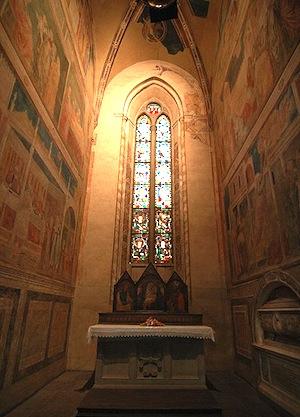Researchers in Florence using state-of-the-art techniques have been able to see original details that have not been seen for centuries in some of Giotto’s paintings.
“We have uncovered a secret Giotto” said Isabella Lapi Ballerini, Head of the Florence restoration laboratory the Opificio delle Pietre Dure.
Using ultra-violet light, the researchers were able to see the original lines of Giotto’s paintings in the Peruzzi Chapel in Florence’s Santa Croce Church. The Chapel was painted by Giotto [c.1267-1337] towards the end of his life, in about 1320. The paintings are not, strictly speaking, frescoes as they were painted “a secco” on dry plaster.
Restorations over the centuries had ruined the paintings and in 1700 the Chapel was whitewashed completely. In 1840 restorers removed the whitewash but they used the harsh techniques available to them and then painted over what they found. Even a 1958 restoration did not restore the fine detail to the paintings.
The 2009 team of restorers and researchers, funded by a grant from the Getty Foundation, were examining the Chapel to gather information about its condition. They were amazed when ultra-violet light brought paintings of St John the Baptist and St John the Evangelist back to life. They say that they have seen details such as facial expressions, the shapes of bodies underneath clothing and the folds of the characters’ garments. The full chiaroscuro effect is visible using this technique and the paintings appear three-dimensional.
These are the details which Michelangelo would have seen and the Giotto paintings are believed to have influenced his painting of the Sistine Chapel.
Unfortunately it would be impractical to show the paintings to visitors under ultra- violet rays and long-term exposure to this kind of light could damage them further. The restorers now hope that funding will be provided for a software programme that would enable the public to see the detail.





